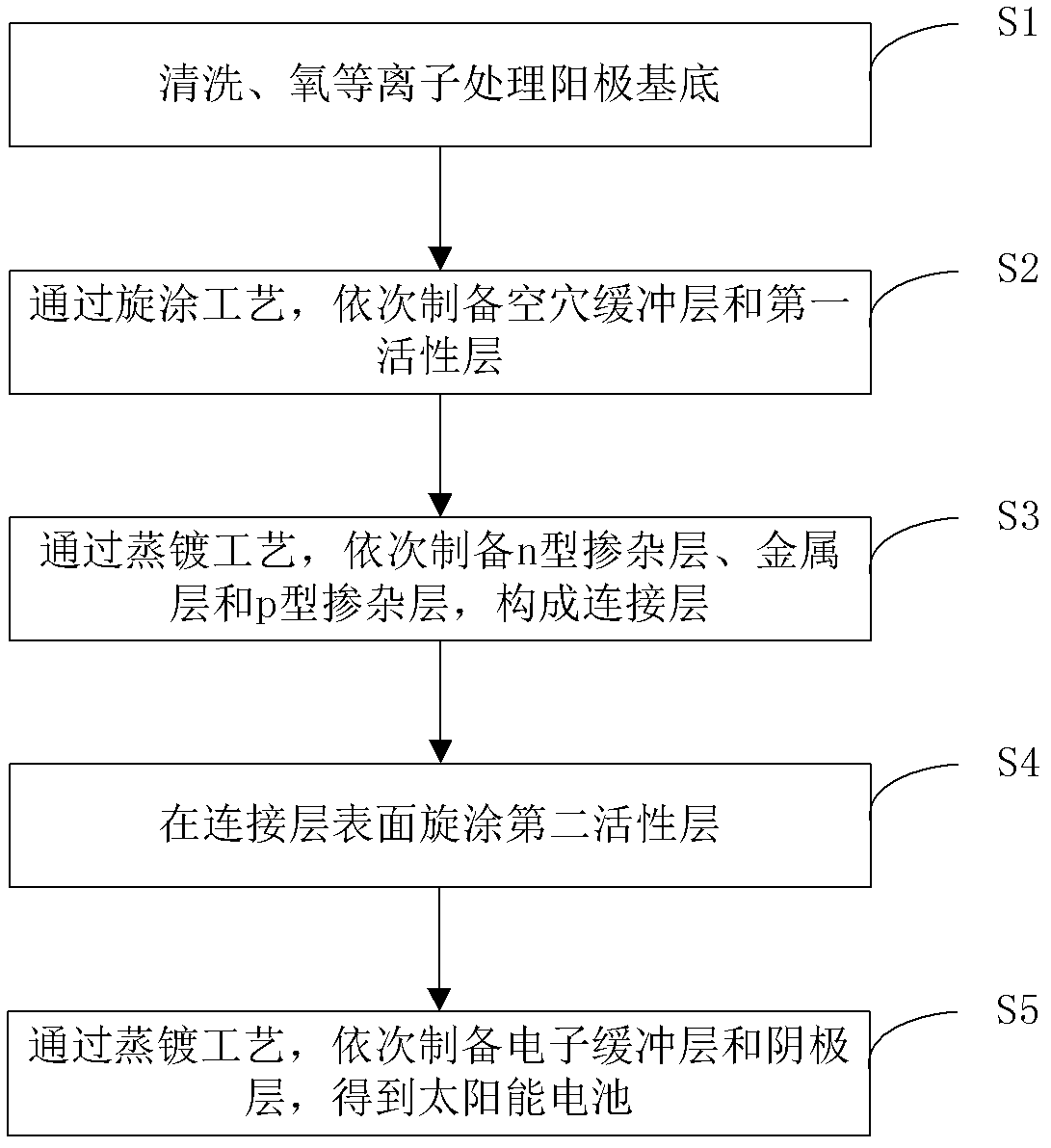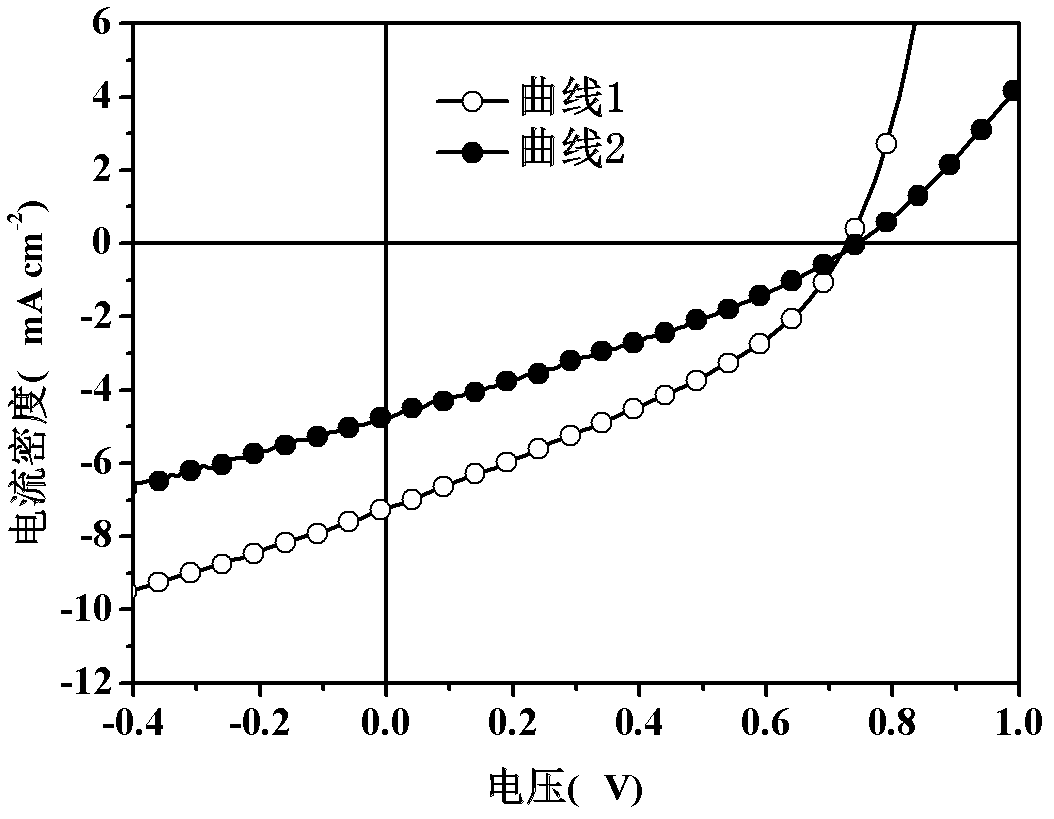Polymer solar cell and preparation method thereof
A technology for solar cells and polymers, applied in the field of solar cells, can solve the problems of restricted efficiency, limited solar light absorption, low photoelectric conversion efficiency, etc., and achieve the effects of avoiding failure, improving conductivity, and improving injection efficiency.
- Summary
- Abstract
- Description
- Claims
- Application Information
AI Technical Summary
Problems solved by technology
Method used
Image
Examples
preparation example Construction
[0038] The preparation method of above-mentioned polymer solar cell, such as figure 2 As shown, the process steps are as follows:
[0039] S1. Ultrasonic cleaning the anode base in detergent, deionized water, acetone, ethanol, and isopropanol for 15 minutes each to remove organic pollutants on the surface. After cleaning, oxygenate it at a power of 10-50W. Plasma treatment for 5-15 minutes, or UV-ozone treatment for 5-20 minutes;
[0040] S2. Spin-coat a hole buffer layer with a thickness of 20-80 nm on the anode surface of the anode substrate, and then spin-coat a first active layer with a thickness of 80-300 nm on the surface of the hole buffer layer after drying, and then dry it;
[0041] S3, vapor-depositing an n-type doped layer with a thickness of 20-80 nm on the surface of the first active layer, then vapor-depositing a metal layer with a thickness of 10-50 nm on the surface of the n-type doped layer, and then vapor-depositing a thickness of 20-50 nm on the surface of ...
Embodiment 1
[0049] The structure of the polymer solar cell in this embodiment is: ITO substrate / PEDOT:PSS / P3HT:PCBM / Li 2 CO 3 :Bphen / Ag / MoO 3 :TAPC / P3HT:PCBM / LiF / Al.
[0050] The preparation process of the polymer solar cell is as follows:
[0051] 1. Clean the ITO substrate with detergent, deionized water, acetone, ethanol, and isopropanol in sequence, and ultrasonically clean for 15 minutes each to remove organic pollutants on the glass surface. After cleaning, clean the ITO layer of the ITO substrate with power Oxygen plasma surface treatment under 10W condition for 15min;
[0052] 2. PEDOT:PSS aqueous solution (wherein, PEDOT:PSS weight ratio is 6: 1; The total mass percent of PEDOT and PSS is 1.3wt%) is prepared on the ITO layer surface of ITO substrate by the mode of spin coating; Heating at 200°C for 30 minutes to prepare a hole buffer layer with a thickness of 40 nm;
[0053] 3. Spin-coat the P3HT:PCBM chlorobenzene solution system on the surface of the hole buffer layer. Aft...
Embodiment 2
[0066] The structure of the polymer solar cell in this embodiment is: IZO substrate / PEDOT:PSS / P3HT:PCBM / LiF:PBD / Al / WO 3 :NPB / P3HT:PCBM / Li 2 CO 3 / Al.
[0067] The preparation process of the polymer solar cell is as follows:
[0068] 1. Clean the IZO substrate with detergent, deionized water, acetone, ethanol, and isopropanol in sequence, and ultrasonically clean for 15 minutes each to remove organic pollutants on the glass surface. After cleaning, clean the IZO layer on the IZO substrate Oxygen plasma surface treatment at 50W for 5 minutes;
[0069] 2. PEDOT:PSS aqueous solution (wherein, PEDOT:PSS weight ratio is 2: 1; The total mass percent of PEDOT and PSS is 1wt%) is prepared on the IZO layer surface of IZO substrate by the mode of spin coating; Heating at ℃ for 60min to prepare a hole buffer layer with a thickness of 20nm;
[0070] 3. Spin-coat the P3HT:PCBM toluene solution system on the surface of the hole buffer layer. After the spin coating, anneal at 50°C for 10...
PUM
 Login to View More
Login to View More Abstract
Description
Claims
Application Information
 Login to View More
Login to View More - R&D
- Intellectual Property
- Life Sciences
- Materials
- Tech Scout
- Unparalleled Data Quality
- Higher Quality Content
- 60% Fewer Hallucinations
Browse by: Latest US Patents, China's latest patents, Technical Efficacy Thesaurus, Application Domain, Technology Topic, Popular Technical Reports.
© 2025 PatSnap. All rights reserved.Legal|Privacy policy|Modern Slavery Act Transparency Statement|Sitemap|About US| Contact US: help@patsnap.com



